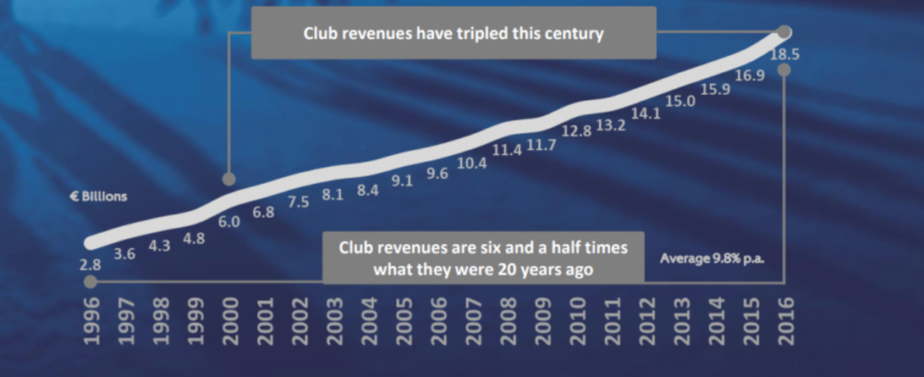Co-authored by Parkhee Rattan & Tanay Gokhale
A few months ago, Neymar Jr. shifted from FC Barcelona to Paris St. Germain for a whopping sum of 222 million euros. The highest transfer amount before that was of Paul Pogba (Juventus to Manchester United) for 105 million Euros, and before that, Gareth Bale, (Tottenham to Real Madrid) for 100 million Euros. That the clubs can afford to shell out so much money for individual players, is an indicator of just how much money is up for grabs in the world of European football. The ninth UEFA report, which highlights the benefits of introducing and implementing Financial Fair Play in European football, agrees.
Financial Fair Play – What is it?
The Financial Fair Play (FFP) regulations were included by the UEFA in a bid to improve the financial health of football clubs and prevent losses and bankruptcy. The FFP achieves this by regulating the minimum salaries, transfer fees that club owners need to pay and encouraging clubs to compete within their financial constraints. For example, a club can only spend only 5 million euros more than they earn every assessment period i.e. three years. Moreover, clubs are made to pay their liabilities on time, ensuring minimal unsustainable debt. The broader objective is, of course, to make football an attractive sport to invest in.
The 700 top-division clubs are seeing a growth of 10% annually in their revenue, a figure that was last recorded in 2002. Clubs have managed to invest in long-term fixed assets like stadiums, as against just player acquisitions; the aggregate investment sum exceeded 1 billion euros in 2016.
Clubs are also less financially dependent on donations and one-time revenue sources, and instead have benefited from increased ticket proceeds, coupled with significantly higher sponsorship and broadcasting revenues. They have recorded an operating profit of a record 800 million euros, even in the wake of increased player wages and a 105% increase in transfer expenses. FFP has also helped reduce bottom-line losses to less than one-sixth of those observed in the past years. This has been complemented by a steady reduction in aggregate debt and an upward trend in net assets.
Club Revenues
On a whole, European top division club revenues – both short and medium term – have risen substantially since the FFP has been implemented.

Figure 1.1: Club revenues have tripled since the start of the century. Source
From 2010-2016, in 16 of the top 20 European leagues, clubs have recorded an increased revenue, with English clubs averaging a revenue of 110 million euros per club, followed by German and Spanish clubs at 58 and 44 million Euros respectively. Clubs from the remaining four leagues have also enjoyed revenues of 15-20 million euros.
Yet another indicator of European football’s increasing financial well-being is the number of clubs which have racked up revenues of more than 50 million and 100 million Euros. While the former rose from 86 to 94, the list of 100 million Euro earning clubs saw two new additions. The combined European club revenue has seen a steady increase, albeit with the characteristic disparity across clubs from different countries.
Tallying the Other Side
Improved revenue figures have been accompanied by increased operating costs. While this may seem ominous on the outside, most of these costs are from fixed asset sources or are matchday expenses. Moreover, a lower proportion of revenue is being used to cover non-wage operating costs, from 39% in 2010 to 33% in 2014. The trend has reversed in the past two years though; the primary reasons thought to be one-time expense like impairments and general cost inflation. These operating costs are predicted to increase further as clubs expand their activities.
Outside the top 20 leagues, clubs tend to have higher costs as a percentage of their revenues, with the average being 50%. With these numbers in mind, it is clear that clubs need to make their player transfer profits in order to balance revenues and costs.
So Has it Helped?
These revenue-cost statistics mostly paint a picture of European football being a profitable industry. The trend of clubs reducing their debts as a result of FFP was seen in 2015-16. However, the report highlights that a record 26 leagues recorded profits in 2016-17 indicating that it was not a one-off phenomenon. Apart from the cost and revenue related regulations, FFP also demands a greater scrutiny of all participant clubs’ financial data, a process through which the UEFA is aware of all the overdue payables of a club.
We must note that financial discrepancies between the top tier clubs and the less popular counterparts are huge; TV revenue from the ‘Big 6’ leagues is more than 11 times that of the other 48 leagues. The major determinant in this polarization of financial gains stems from the big clubs’ ability to leverage their brand to bag great sponsorship deals. While the 12 largest and most global brands managed to rake in 1.53 billion euros through sponsorship, the remaining top division clubs showed just 700 million euros for the same. Apart from this issue, lack of streamlined financial data and a general cost inflation can eclipse the benefits of this policy.
However, despite these inequalities, if the ninth UEFA report is to be believed, the introduction of the Financial Fair Play regulations has come through for the European clubs. On the whole, Financial Fair Play looks like it’s here to stay, with many nations adopting their own set of regulations on similar lines.
Featured image courtesy Antoine Dellenbach|CC BY-SA 2.0






